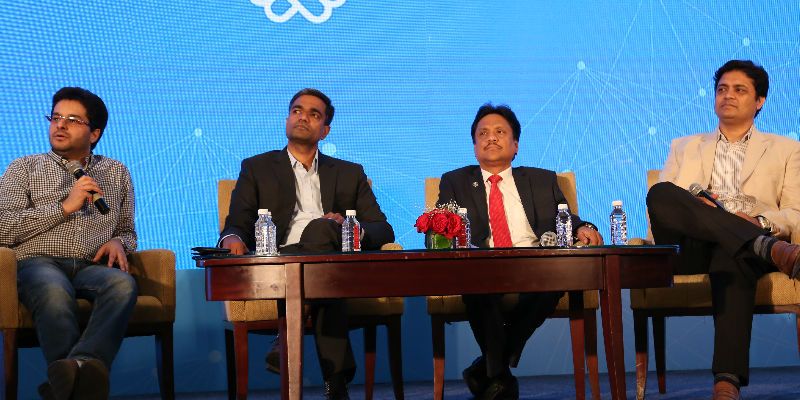
Cisco
View Brand PublisherFrom investing in the right technology to the impact of digital disruption for businesses, the CISCO YourStory event reiterated why the future is digital
With a theme focussing on “Future of Business is Digital”, it was only natural that the demo lounge at the recently-held Cisco YourStory event in Bangalore showcased how the right technology could aid companies in their digital journey and make their operations more efficient and secure.
The technology showcase
Some of these solutions included the Software-Defined WAN (SD-WAN) , an overlay architecture which overcomes the biggest drawbacks of traditional WAN by building a secure, unified connectivity over any transport (MPLS, Broadband, LTE, VSAT etc.), thereby simplifying operations with centralised management, policy control and application visibility across the enterprise.
Another solution showcased at the event was the Cisco Webex, the enterprise solution for video conferencing and web conferencing, which enables users to join online meetings, presentations, webinars, town halls, online courses, and trainings, from any browser, device, or system. The solution’s highlight was the Cisco Webex Board, an all-in-one smart whiteboard and video screen, which enables video conference call hosts to sketch on the board’s touchscreen and let team members mark up the drawing from anywhere.

A demo of Cisco Meraki, the cloud controlled Wi-Fi, routing, and security, exhibited how it simplifies IT by enabling managing entire networks from a single dashboard, centralised control of users, applications, and devices, integrated firmware updates and feature releases and much more.
Why it’s time for businesses of all sizes to adopt intuitive and intelligent network
Delivering the key note address on the occasion, Prem Nithin, Head – Enterprise Networking Business, Cisco India & SAARC, spoke about how digitalisation has disrupted every industry – from retail, healthcare, education, finance and telecom, to media and entertainment. He highlighted how new-age technologies like Artificial Intelligence, Virtual Reality, Robotics and Virtual Augmentation are changing everyday life. “Today, we are seeing a huge shortfall of passive network technology such as capacitors and inductors, especially in the South East Asian market. The reason is that home automation is growing at a supersonic pace and the industry has already placed a massive order for these which is becoming difficult to fulfil. That is the scale of digitalisation that is happening and taking the wheel of innovation ahead.”

He highlighted how, in spite of these advances, two critical aspects remain ignored. One is data security and the second is investing in the right technology. “Security is foundational to not just technology-based or technology-enabled businesses, but every business today. Just as innovation and technology have advanced, so have cyber security risks. So, it becomes imperative for organisations not just to have application or platform level security, but even security at the network level. When the network itself becomes intuitive and intelligence, it will weed out threats even before they can enter the system and cause havoc. And, because many businesses do not understand the importance of having security at the network level, a lot of cyber-attacks are happening here.”
And one such solution which can help businesses is Cisco Intent-Based Networking. Nithin highlighted how the solution provides insights and visibility for enterprise networks, 360-degree contextual insights across users, devices, and applications and network performance with real-time and historical data analytics, in addition to detecting problems even before they happen.
“Businesses can benefit from technological solutions that not only identify the devices but also the users. And once the users get authenticated by the network, they are given access to those resources which are required. The second important element is that as business owners you need to control applications that are traversing in the network. The visibility enables you to secure the data and detect malicious viruses and malware in encrypted traffic before they begin to act and affect your business.”
Correlation between digitalisation, disruption, and the future of economy
The interesting key note address was followed by an panel discussion on how digitalisation is playing the role of enabler for small businesses, how government regulations are impacting businesses, the changes the businesses must be geared for in the era of Industrialisation 4.0, understanding digital compliance, whether infrastructure woes were hindering the pace of innovation for startups and SMBs in India, reasons why startups fail, and which is the next hotbed of growth that businesses must focus on.

The panellists included K Ravi, President, FKCCI; Vishal Chopra, CRO, Lendingkart; Vikas Lachhwani, Co-Founder, MCaffeine and Nithin. The discussion was moderated by Vishal Krishna, Business Editor at YourStory.
Sharing his views on how digitilisation has helped a niche startup like MCaffeine to compete and thrive in a competitive marketplace, Vikas said, “We are a team of six people operating from two different locations in two different states. We do not own a supply chain, a warehouse or a retail outlet, yet our business is growing and we are able to operate efficiently. And digitalisation has been the key component here, because technology and digitalisation enable us to control the discrete and fragmented aspects of our business.”
Ravi shared anecdotes and observations from his visits to numerous countries. “Digitalisation is only going to get bigger. And we must reinvent ourselves to stay competitive and relevant. For instance, with robotics being seeded in actual use case scenario, economies that are dependent on income generation from the garment or BPO industry are likely to be impacted the most.” Sharing his take on India’s economy which is becoming digitalised, he said, “With the introduction of GST and increased emphasis on online transactions, traditional businesses are now coming into the foray of the formal economy. While a lot needs to be done to make the process more seamless for traditional businesses, the key understanding is that digitalisation is definitely here to stay.”
The panel discussion saw the speakers explaining why Tier 2 and Tier 3 cities will be a key focus area for businesses which are looking to drive the next phase of growth in India’s economy,
The Lendingkart CRO asked, “Why should every business operate out only out of metros?”
Giving an insight into the potential of rural and semi-urban areas, Vishal said, “We exist because we are able to cater to Tier 2 and Tier 3 cities. As of February 2018, we have raised a total of $114 million in equity funding and close to $60 million in debt funding cumulatively. That speaks for the success of our business.” He added, “Lendingkart is headquartered in Ahmedabad and 70 percent of our workforce operates from there. In other words, you can build big businesses beyond the purview of the metros. Today, the real India is the rest of India, and that is where the next big revolution in the Indian economy is going to come from.”
The event reverberated well the audience members, who were a diverse mix from startups and SMEs across manufacturing, education, hospitality, renewable energy, real estate and technology. If there was one overarching message that the event conveyed, it was that investing in the right technology is as critical as going digital, and that businesses must be geared up for disruption as digitalisation will continue to push the bar of innovation higher.











